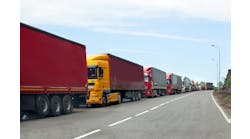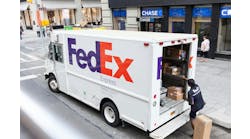Because of the nature of its business, propane tank supplier Blue Rhino needs a portable, hand-held wireless unit that's rugged and easy to use. "The driver is key to our success," explains Bob Travatello, the company's chief information officer. "We have to make sure when our drivers go out with a full load of tanks that the trucks don't return half empty."
Thanks to wireless technology, a shipper's home office can now know where a shipment is without the need for the driver to punch a button or call in. Blue Rhino, for instance, uses wireless devices from Hand Held Products Inc. along with other routing tools to make sure it knows which stores need servicing, Travatello explains.
Blue Rhino supplies both propane tanks — the kind used for barbeque grills and the gas that goes in them. Final customers bring empties to Blue Rhino locations — they're in all 50 states, Canada, Puerto Rico and the Virgin Islands — and exchange them for full tanks or buy a new one if needed. The company also offers ancillary products that use propane. While the biggest portion of its market is gas grills, the company also offers heaters and mosquito control products.
"Nobody orders our product," Travatello explains. "We manage the inventory. We are a direct store delivery vendor. Our outlets don't tell us they want to order a given number of tanks. We monitor the inventory at all locations as well as all of the billing, accounting, information technology functions and the like in our North Carolina offices. We also use sales trends from past deliveries."
Blue Rhino makes its deliveries with a buffer, meaning it leaves an essential number of tanks at each site so a customer will never be left without a tank. It has more than 33,000 customers, with 60 distribution points around the country where the company refills and handles any necessary refurbishment on older tanks — including painting, testing and refilling.
The company has 20,000 convenience store locations across the country as well as sites within many gas stations. It owns half of its distributors, the other half being independent dealers. Pickup, filling, refurbishing and delivery is not outsourced anywhere. All drivers are hazmat certified. Blue Rhino has more than 300 drivers, with that number swelling to 400 when seasonal drivers are added in the summer.
With the size of the market, the last thing Blue Rhino wants is a lot of paper coming back to the office. Using wireless communications devices from Hand Held Products Inc., all data from all drivers across the country is downloaded at the end of the day, when they've finished their routes. The information is then processed and invoiced to the customer. "The wireless devices are the main conduit for all of that transactional data," says Travatello. "We built business intelligence on the front end of the Hand Held devices, so all the built-in rules per customer are already on the device. When the driver completes a delivery, that information moves seamlessly to us. We already know if they need a purchase order number or any other sort of information."
The wireless device is able to capture a signature electronically by creating an image, which it relays to Blue Rhino.
"We have an actual physical copy of the ticket," says Travatello.
Typically Hand Held devices contain a General Packet Radio Service (GPRS), which determines where vehicles are at any moment, providing real-time communication through the wireless network, notes Kevin Ahearn, Hand Held's vice president and general manager of mobile and wireless products. They also have the imaging ability to produce proof of delivery. Devices can grab a signature, then time and date stamp it. Hand Held also has the ability to grab a global positioning system (GPS) location to determine time and date and where it was delivered, and send that information immediately back to the GPRS network. Travatello has been with Blue Rhino since the company was founded in 1994. "We used to have a ton of paper that had to be keyed. There was a host of problems — pricing, keypunch errors, missing tickets and so on. Now all pricing and other business functions are built into our wireless devices ahead of time."
Michael Dougan, vice president and chief financial officer of Dependable Supply Chain Solutions, a third-party logistics provider (3PL), looks at wireless communications as the "EDI of this decade." The 3PL uses Qualcomm for its truckload operations and has recently begun using KonaWare Inc. for its less-than-truckload (LTL) operations.
"A decade ago, the first question everybody asked was, 'Do you have EDI [electronic data interchange] capabilities?'" remembers Dougan. "I think 90% of companies still don't use it, but it was one of those watershed questions because it determined your capability from an information technology standpoint. Mobile communications are now the hotbutton item."
Dependable's menu of logistics services includes trucking, warehousing, consolidation, distribution, airfreight and freight forwarding. The company has a consolidation group that does national LTL and has a strong regional LTL presence from its eight terminals in California, Arizona and Nevada.
"We use our wireless communications for a good return on investment," Dougan says. "It gives us instant visibility, tells us where our drivers are, and lets us communicate. We're saving money on our administrative staff and our dispatch and communications."
"Rather than having to spend thousands of dollars per driver for a device and expensive air time, you can purchase a device that's almost an expendable, throw-away item, like a cell phone," explains Jeff Amerine, KonaWare's vice president of transportation and logistics." His company, for instance, has developed a software platform that can run transportation and logistics applications on a variety of hand-held devices. These applications are integrated to the user's back office systems, on a low cost communications link, such as public wireless networks available from Cingular, TMobile and Nextel.
When Dependable's drivers reach delivery destinations, they hit a button on the hand-held device, which takes them through a delivery scenario, including an OS&D (over, short and damaged) module. The software notes all delivery requirements and the consignee signs off on the delivery. Pickup locations are sent to drivers. The program takes them through all pickup requirements, through a pro number to pallet weight and destination zip code. The data is sent to Dependable, so the carrier is able to begin building its outbound.
Drivers for Duplainville Transport Inc. are required to go through a set of codes for pickup and delivery, along with other information, explains John Drake, the truckload carrier's fleet manager. For example, they have to enter the trailer number of the one dropped and the one picked up, and to type in the consignee's name.
"Detention time is a big issue for us, like the rest of the industry," Drake says. "Drivers send 'arrived at consignee' delivery time and then the time they leave that location. We verify those times when the truck starts to move."
Duplainville is a wholly owned division of Quad Graphics, with both contract and common carrier authority. Drake estimates that 60% of its business is printed material and another 30% is material for another division of Quad Graphics, which has six print plants throughout the U.S. With its fleet of 150, Duplainville covers 48 states.
For wireless communication, Duplainville uses equipment from Geo-Logic Solutions. Drake cites two reasons that motivated the carrier to adopt wireless in-cab communications. One reason was simply to enable communication with drivers without the use of cell phones or land lines. The other reason was so that trucks could be tracked. With that data, customers can visit the Duplainville website in order to locate their shipment.
"We have a tracking and tracing department that handles every load that goes out of one of our plants," Drake explains. "The information comes from the GeoLogic unit, goes through our computer software, and then goes into our tracking and tracing group. If a load is running behind, they'll call us and ask why."
Since about 90% of what it ships is its own product, most deliveries are extremely time critical. If copies of Newsweek or Sports Illustrated, which Quad Graphics prints, aren't delivered to magazine distributors on time and arrive late to the newsstands, they might as well be shredded, notes Drake. "We also print a lot of newspaper material," he explains. "It all has to be delivered by Thursday of the week for Sunday papers. We'll print the farthest destinations first and work our way back to the closest."
Duplainville also has a tanker division, hauling some hazmat and quite a bit of its own ink for some of its gravure presses. Those loads are monitored because they are highly flammable, highly explosive material.
For Morgan Southern Inc., an intermodal drayage company, geofencing is a key reason it adopted the web-based PeopleNet system. A geofence is a boundary set around a specific point that may be located by use of GPS technology.
According to Ben Kirkland, Morgan Southern's vice president, operations, a number of geofences have been established to automatically inform the carrier when drivers have arrived at particular points. "We do service-sensitive automotive business from the Southeast up to the rails in Chicago," he says, "as well as service-sensitive package delivery to the Chicago rails for FedEx Ground. In all of this, it is very important that we make those rail cuts and that the customer is notified that we are there."
Morgan Southern has 18 locations around the country, with its central road operation running out of Atlanta. The carrier mixes and mingles its long haul dry van customers with its long haul intermodal. Generally, its intermodal runs are between 700 and 800 miles.
Morgan Southern is currently using PeopleNet's high-speed digital network, which includes driver e-mail capabilities that enables a driver to communicate with friends or family at no charge. Kirkland likes having e-mail capabilities for his drivers. "I can now send a broadcast e-mail to every driver," he notes. "We're going to use that capability as a way for corporate management to better communicate with the drivers."
Before installing Cube Route, Reliable Food Supplies Inc., a Canadian wholesale distributor, used a bulkier wireless system for its 14 tandems and one trailer private fleet. Being in the food business, all units are reefers operating out of its one distribution center (DC). Inbound comes from suppliers, a thirdparty carrier and by Reliable's own trucks when they have to, explains Tony Priaulx, the company's information technology manager.
With the older system, drivers would enter information throughout the day and when the shift was over, they would return to the warehouse, get a data cartridge, upload the information to a PC, then print it out. One of the drawbacks was that some drivers would get back to the warehouse late and none of these reports would be looked at until the next day, notes Priaulx.
Part of the Reliable back end system is software that optimizes routing. As a result, Cube Route provides a distinct advantage over the old system in that it works in real time. "Sometimes we'd have a new driver and not find out until halfway through the day that there had been only two calls in four hours," says Priaulx. With Cube Route's GPS functionality, it's now possible to see where all 14 trucks are at any time.
The Cube Route service used by Reliable Food will track vehicles using any wireless-to-web device. Drivers were already using Java-based mobile phones, so the switchover was seamless. It captures a great deal of data in real time, including mileage, productivity tracking, timecards, exception handling, temperature and signatures.
At present Reliable Food drivers interact via cell phone, and every evening their next day's routes are uploaded to the Cube Route website, where the route information is formatted to their phones' configurations. When drivers arrive for work the next day, their routes are already on their phones.
"Drivers interacting via phone tell us when they punched in, left for the first stop, arrived at the first stop, and when their deliveries start and are finished," says Priaulx. "Part of the wireless system's functionality is to estimate driving times, which we use as a customer service feature. If a customer calls asking when to expect delivery, we can very quickly look on the Internet and give an estimated time of arrival. We can now use driving distances and speeds on roads to formulate a drive time."
"Wireless technology reduces the empty miles drivers run while eliminating wasted time while they try to make contact with dispatch," says Norman Ellis, vice president and general manager of Qualcomm's wireless business solutions group.
He also points to the back office benefits of wireless communication. "A company can have direct input into payroll, accounts payable and receivable, and of course, dispatch," he notes. "Wireless systems share data up and down an organization that allows them to make decisions about inventory availability and deliveries for billing purposes."
Ellis points, as well, to the importance of wireless data in regulatory compliance. For reporting of fuel taxes, for example, geofencing and other monitoring tells when trucks cross state lines and how many miles they run. Hours of Service data is more easily reported wirelessly, helping to ease driver writing and reporting burdens.
While back office data and operations can benefit greatly from the use of wireless communications, ultimately movement of shipments still comes down to a driver and a truck.
"In the end," says Dependable's Dougan, "these devices are not going to drive the trucks. All they're going to do is help you to make the job better for those who are driving the trucks."
Looking for the next Next Big ThingAnalyst firm Nucleus Research Inc. (www.nucleusresearch.com), which specializes in tracking return on investment (ROI) from technology, sees the following tech trends dominating the marketplace throughout the coming year: Business intelligence will be the latest carrot ERP vendors will use to attract new customers. As business intelligence emerges as a method of extracting data from ERP (enterprise resource planning) systems, ERP vendors will offer expanded capabilities to provide one-stop shopping. Maintenance fees will become the next software battlefield. The heavy merger and acquisition activity in the software market is based on acquiring new customer bases and adding more lucrative maintenance fees to the vendors' bottom lines. Customers are getting tired of paying for upgrades they may never need and licenses they rarely use, so they'll start getting tougher on negotiating fees. With RFID, it's not about cost — it's about reliability. Better technology, more vendor and user experience, more mature supporting software, and emerging best practices will help make the RFID (radio frequency identification) ride a bit smoother in 2005. More companies will outsource their e-retail channels instead of maintaining and updating costly on-premise e-commerce and catalog applications. Companies that invested heavily in e-commerce platforms in the 1990s will reevaluate their ongoing software maintenance, support and content management costs and consider hosted alternatives. Companies will undergo infrastructure audits to identify and clean out redundant or unnecessary IT (information technology) assets. They are looking at ways to standardize systems across the company and will spend to replace disparate systems with a single unified system. The payoff can be substantial with significant returns from system retirement and ongoing returns through lower IT support costs. |
Decoding the buzzwordsBluetooth is a short-range wireless technology used to connect electronic devices such as cell phones, palm top computers, digital cameras and more and to exchange data at rapid speed. Fun fact: It is named after the Danish king who united Norway and Denmark, Harald Blatand, which translates as Bluetooth. ECM is an Engine Control Module that monitors engine operations, relays such data as engine condition and idle time, and can set preventive maintenance alarms. Geofence is a boundary set around a specific point that may be located by use of GPS technology. GPRS is General Packet Radio Service. These networks enable functions such as color Internet browsing and the ability to access e-mail while in motion. GPS stands for Global Positioning System. The GPS constellation is 24 satellites that orbit the earth in 12 hours. They send radio signals that permit receivers to convert these signals into position, velocity and time data. Wi-Fi, or Wireless Fidelity, allows connection to the Internet. As long as computers are in range of a base station, they may send and receive data. |
resourcesBlue Rhino Cube Route Dependable Supply Chain Solutions www.dependableinc.com GeoLogic Solutions Hand Held Products Inc. KonaWare Inc. Morgan Southern Inc. www.morgansoutherninc.com PeopleNet Qualcomm Reliable Food Supplies Inc. www.reliablefoods.com |


